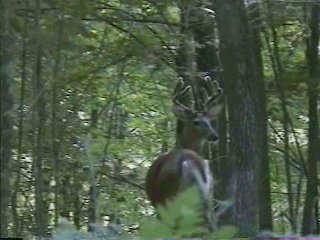
white tailed buck ,boy deer
They usually travel in small groups of three or
fewer animals (a doe female deer and
fawns baby deer). The
male (men deer) have antlers which are shed each winter, and grow a new
each each spring or summer. female (girl deer) do not have antlers.
Description
A tan or reddish brown in the summer and greyish-brown
in the winter, the belly, throat, nose band, eye ring and insides of the
ears are white. There are black spots on the sides of the chin. Deers are
long legged fast animals. Deer are extremely cautious animals with
keen senses of smell and hearing. . Both White-tailed
and Mule deer can run as fast as 40 miles per hour and
are good swimmers. When a number gather together
trampling down the snow in an area, it is known as a ''deer yard".

Behavior
Behavior and habitat preferences also distinguish the species. White tails are wary and secretive, traveling and feeding primarily at sundown and during the hours immediately afterward, and again in the hours before dawn. They usually stay in or close to timber, creeks and shelter belts, and they bolt for cover at any hint of danger. At home in farm country, white tails are the predominant species in eastern Nebraska, but they have extended their range, moving westward along rivers and streams
Mating and Birth
The mating season for white-tailed deer occurs
in October through January. Fawns are born in April through July. Fawns
are born with spots to help camouflage them.
 |